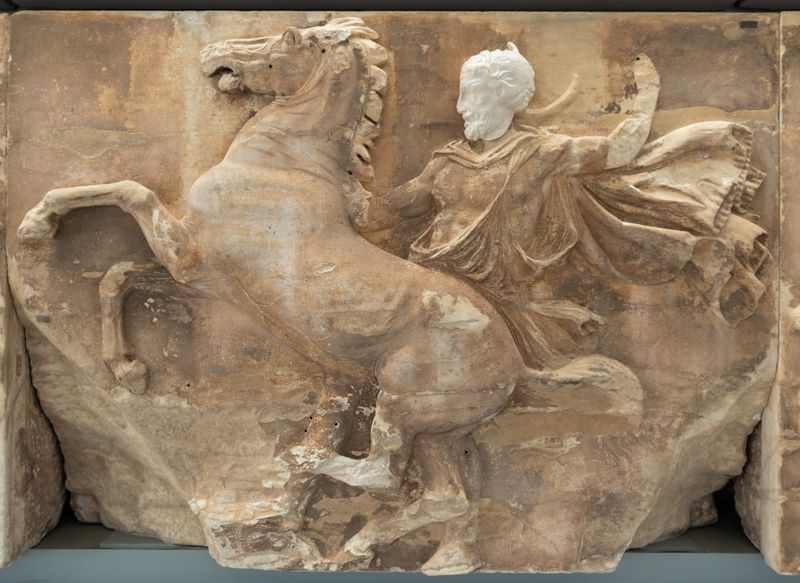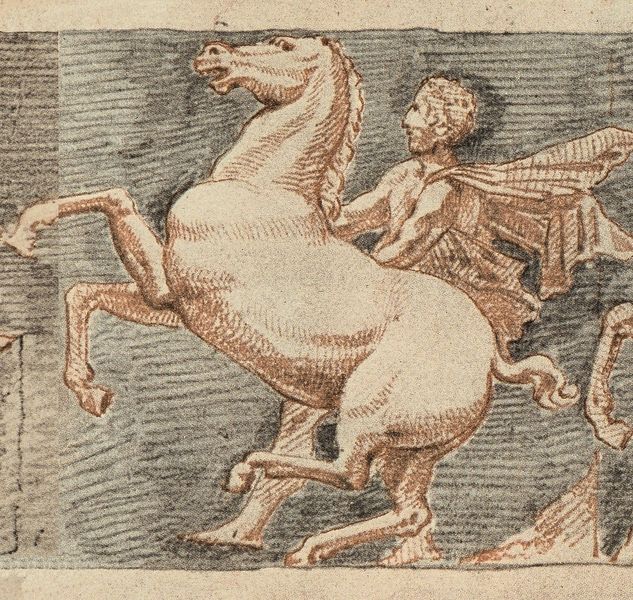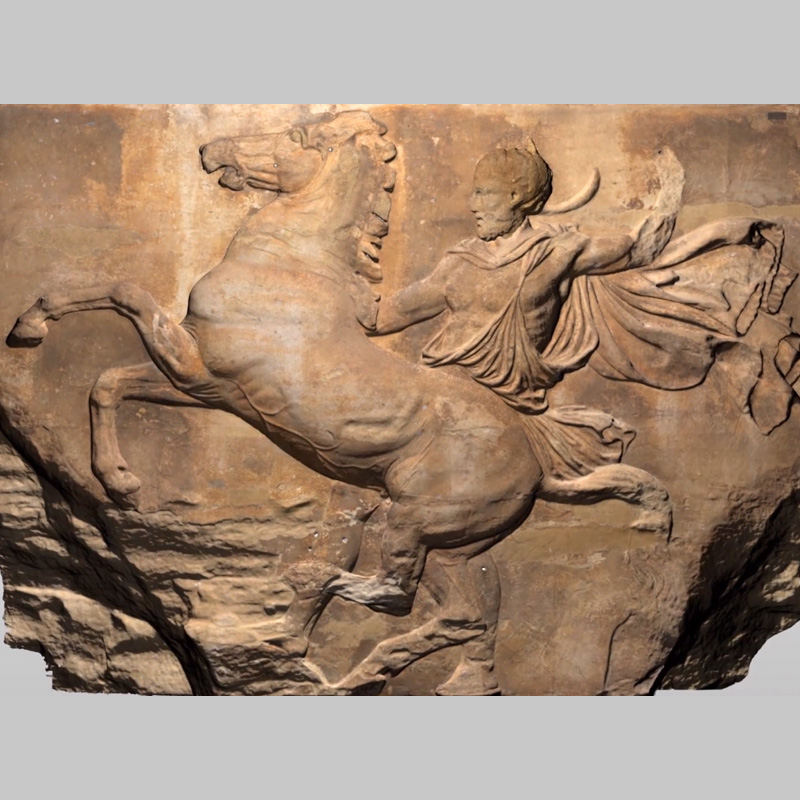Parthenon. West frieze. Block 8 (VIII)
Inventory number
Ακρ. 20022
Artist
Pheidias
Category
Architectural sculpture
Period
Classical Period
Date
442-438 BC
Dimensions
Height: 1.01 m
Length: 1.395 m
Width: 0.595 m
Material
Marble from Penteli
Location
Parthenon Gallery
On block VIII a bearded rider tries to restrain his spirited horse by pulling decisively the reins which were once rendered in bronze. In order to keep his balance, the horseman braces his right foot firmly against a rock whereas the resistance of the horse is shown by its swelling veins. The horseman wears an exomis, and above it a chlamys that flaps out behind him in deep folds. The cap on his head is of fox skin (alopeke), while on his feet he wears boots, their fold-over tops also originally made of added bronze. His face is a copy of the original which was lost between 1802 and 1870.
This block stands out because of its inventive composition and skillful execution which indicate a creator of exceptionally high standards, perhaps Pheidias himself. The rider is usually identified with one of the two Hipparchoi, the commanders of the Athenian cavalry. Others say he may be a Thracian ally of the Athenians, since his attire is characteristically Thracian, as is the case with the bearded horseman on block IV (Ακρ. 20018). Those who attribute a mythological interpretation to the frieze consider the horseman to be the mythical king of Athens, Theseus, who united the scattered settlements of Attica and founded the celebration of the Panathenaia.
The frieze on the west side of the Parthenon shows the riders preparing to take part in the procession of the Athenian people during the Panathenaic festival, in honour of the protectress of the city, Athena. The procession's destination was the Temple of Athena Polias on the Acropolis. Its purpose was the transportation of the Panathenaic peplos destined to adorn the age-old xoanon of the goddess and the offer of a grand sacrifice of animals at the Great Altar outside of the temple.
The horsemen on the west frieze are in the Kerameikos, where the procession started. Some converse, some others fasten their sandals, some of them bridle their horses or try to soothe them, while a few horsemen are already galloping in loose formation.
The west frieze is preserved almost intact as the bombardment of the Parthenon by the Venetians under the command of the general Francesco Morosini in 1687 did not affect this side of the temple. Its total length is 21.18 m and is composed of sixteen blocks. Fourteen of them are displayed in the Acropolis Museum after they were removed from the Parthenon in 1993 and kept in the old Acropolis Museum for fifteen years. Blocks I and II are in the British Museum in London, where they ended up after they were forcibly removed by Thomas Bruce, lord of Elgin, between 1801 and 1804, when Greece was still under Ottoman occupation.
Michaelis, Α., Der Parthenon, Leipzig, 1870-1871, σελ. 203-228:1-26, 229, 231, πίν. ΙΧ, αρ.κατ. Platte VΙΙΙ
Smith, A.H., British Museum. The Sculptures of the Parthenon, London, 1910, σελ. 61, πίν. 66
Schuchhardt, W.H., «Die Entstehung des Parthenonfrieses», Jahrbuch des Deutschen Archäologischen Instituts 45, 1930, σελ. 254-264
Lippold, G., Die griechische Plastik, Handbuch der Archäologie III 1, München, 1950, εικ. 53.2
Fehl, P., «The Rocks on the Parthenon Frieze», Journal of the Warburg and Courtauld Institutes 24, No. 1/2 (Jan. - Jun), 1961, σελ. 3, 27
Bowie, Th., Thimme, D. (εκδ.), The Carrey Drawings of the Parthenon Sculptures, Bloomington, Indiana University Press, 1971, σελ. 55, 58, πίν. 15
Brommer, F., Der Parthenonfries, Mainz, 1977, σελ. 12-14, εικ. 3.1, 4.1, 23-26, 28.2, αρ.κατ. W VIII 15
Παλαγγιά, Ό., Ο γλυπτός διάκοσμος του Παρθενώνα, Αθήνα, 1983, σελ. 48, 49-50
Beschi, L., Il fregio del Partenone: una proposta di Lettura, Atti della Accademia Nazionale dei Lincei, serie 8. Rendiconti, Classe di Scienze morali, storiche e filologiche 39, 1984, σελ. 186-188, 194-195 (App. VII), εικ. VII
Boardman, J., Finn, D., The Parthenon and its Sculptures, London, 1985, σελ. 238, 240-241, εικ. 15, πίν. 125-126
Beschi, L., «Η Ζωφόρος του Παρθενώνα. Μια νέα πρόταση ερμηνείας», στο H. Kyrielies (επιμ.), Archaische und klassische griechische Plastik, Τόμος 2. Akten des internationalen Kolloqiums vom 22- 25. April 1985 in Athen, Rheim am Mainz, 1985, σελ. 215-220, 223, εικ. 8
Harrison, E.B., «Hellenic Identity and Athenian Identity in the Fifth Century B.C., Studies in the History of Art», Symposium Papers XII: Cultural Differentiation and Cultural Identity in the Visual Arts, Hanover/London, 1989, σελ. 50
Δεληβορριάς, Α., «Ο γλυπτικός διάκοσμος του Παρθενώνα», στο Π. Τουρνικιώτης (επιμ.), Ο Παρθενώνας και η Ακτινοβολία του στα Νεώτερα Χρόνια, Αθήνα, 1994, σελ. 125, 132, εικ. 58.15, 72
Σκουλικίδης, Θ., Παπακωνσταντίνου, Ε., Γαλανού, Α., Δογάνη, Γ., Μελέτη Αποκαταστάσεως του Παρθενώνος. Περί της Συντηρήσεως της Δυτικής Ζωφόρου, 3γ, Αθήνα, 1994
Wesenberg, B., «Panathenäische Peplosdedikation und Arrhephorie. Zur Thematik des Parthenonfrieses», Jahrbuch des Deutschen Archäologischen Instituts 110, 1995, σελ. 150, 176-178
Berger, Ε., Gisler-Huwiler, M., Der Parthenon in Basel. Dokumentation zum Fries, Mainz, 1996, σελ. 48-49, εικ. 18-19, αρ.κατ. WEST VIII 15
Harrison, E.B., «The Web of History: A Conservative Reading of the Parthenon Frieze», στο J. Neils (επιμ.), Worshipping Athena. Panathenaia and the Parthenon, Wisconsin, United States, 1996, σελ. 209, εικ. 9.1
Pollitt, J., «The Meaning of the Parthenon Frieze», στο D. Buitron-Oliver (επιμ.), The Interpretation of Architectural Sculpture in Greece and Rome, Washington, 1997, σελ. 51-65
Τριάντη, Ι., Το Μουσείο Ακροπόλεως, Ο Κύκλος των Μουσείων, Αθήνα, 1998, σελ. 252, 281, εικ. 286
Boardman, J., «The Parthenon Frieze, a Closer Look», Revue Archéologique Fasc. 2, 1999, σελ. 325-330
Lagerlöf, M.R., The Sculptures of the Parthenon. Aesthetics and Interpretation, Yale, 2000, σελ. 20-24, 30, 37, 60-79, εικ. 9
Neils, J., The Parthenon Frieze, New York, 2001
Jenkins, I., The Parthenon Frieze, 2nd edition, London, 2002, σελ. 107, εικ. ΙΙ
Παπακωνσταντίνου, Ε., Φραντζικινάκη, K., Πουλή, Π., Ζαφειρόπουλος, B., Μελέτη Αποκαταστάσεως του Παρθενώνος, Αθήνα: ΥΣΜΑ, 2002, σελ. 12
Stevenson, T., «The Parthenon Frieze as an idealized, contemporary Panathenaic festival», στο D.J. Phillips, D. Pritchard (επιμ.), Sport and Festival in the Ancient Greek World, Wales, 2003, σελ. 242, 251-252, εικ. 4
Vlassopoulou, Chr., «The Conservation of the Parthenon West Frieze from the Archaeologist's Point of View», στο C.C. Mattusch, A.A. Donohue, A. Brauer (επιμ.), Common Ground: Archaeology, Art, Science and Humanities. Proceedings of the XVIth International Congress of Classical Archaeology Boston, August 23-26, 2003, σελ. 267, εικ. 1
Younger, J.G., «Work Sections and repeating patterns in the Parthenon Frieze», στο M.B. Cosmopoulos (επιμ.), The Parthenon and its sculptures, Cambridge, 2004, σελ. 63-68, 82-83
Χωρέμη-Σπετσιέρη, Α., Τα Γλυπτά του Παρθενώνα. Ακρόπολη-Βρετανικό Μουσείο-Λούβρο, Aθήνα, 2004, σελ. 165-166, εικ. 130
Symeonoglou, S., «A new analysis of the Parthenon Frieze», στο M.B. Cosmopoulos (επιμ.), The Parthenon and its sculptures, Cambridge, 2004, σελ. 5-6, 36-41
Neils, J., «Classic Moments: Time in the Parthenon Frieze», στο M.B. Cosmopoulos (επιμ.), The Parthenon and Its Sculptures, Cambridge, 2004, σελ. 46, 52
Jeppesen, K., «A fresh approach to the problems of the Parthenon Frieze», στο E. Hallager, J.T. Jensen (επιμ.), Proceedings of the Danish Institute at Athens V, Athens, 2007, σελ. 138
Wrede, H., Das Lob der Demokratie am Parthenonfries, Trierer Winckelmannsprogramme 21, 2008
Patay-Horváth, A., Metallanstückungen an griechischen Marmorskulpturen in archaischer und klassischer Zeit, Tübinger Archäologische Forschungen 4, 2008, σελ. 81-82, αρ.κατ. 33
Βασιλειάδης Κ., Μαράκης, Γ. κ.ά., «Ο καθαρισμός της δυτικής ζωφόρου του Παρθενώνα», Πρακτικά Ημερίδας 2008 Συντηρητών Αρχαιοτήτων & Έργων Τέχνης, Αθήνα, 2009, σελ. 107-113, εικ. 4
Ιωαννίδου, Μ., Λεμπιδάκη, Ε., Η αναστήλωση της Αθηναϊκής Ακρόπολης (ΥΣΜΑ, β' έκδοση), Αθήνα, 2011, σελ. 9
Ellinghaus, C., Die Parthenonskulpturen. Der Bauschmuck eines öffentlichen Monumentes der demokratischen Gesellschaft Athens zur zeit des Perikles -Techniken in den bildenden Kunst zur Tradierung von Aussagen, Hamburg, 2011, σελ. 97-98, 102, 131-132, εικ. 106
Παντερμαλής, Δ., Ελευθεράτου, Σ., Βλασσοπούλου, Χ., Μουσείο Ακρόπολης. Οδηγός, Αθήνα, 2016, σελ. 224, 227, εικ. 273-274
Borbein, A.H., «Die Skulpturen des Parthenon: Wie vollzieht sich Stilentwicklung?», Jahrbuch des Deutschen Archäologischen Instituts 131, 2016, σελ. 107, 109-111, 118-126, εικ. 5c
Tanaka, E., «The Concept of Space in the Parthenon Frieze», στο T. Osada (επιμ.), The Parthenon Frieze. The Ritual Communication between the Goddess and the Polis, Parthenon Project Japan 2011-2014, Wien, 2016, σελ. 119-138
Nakamura, T., «The Clothing and Armour of the Horsemen and Warriors on the Parthenon Frieze», στο T. Osada (επιμ.), The Parthenon Frieze. The Ritual Communication between the Goddess and the Polis, Parthenon Project Japan 2011-2014, Wien, 2016, σελ. 61-82, εικ. 6
Osada, T., «The Parthenon Frieze - Display of Piety and Privilege», στο T. Osada (επιμ.), The Parthenon Frieze. The Ritual Communication between the Goddess and the Polis, Parthenon Project Japan 2011-2014, Wien, 2016, σελ. 11-30
Meyer, M., Athena, Göttin von Athen. Kult und Mythos auf der Akropolis bis in klassische Zeit, Wien, 2017, σελ. 99-100, 104-107












